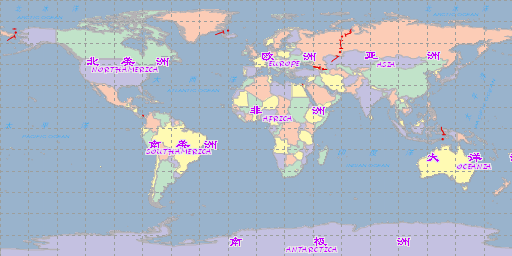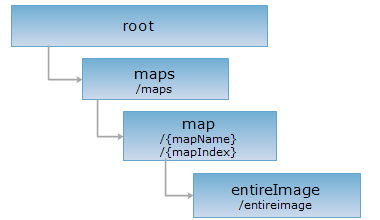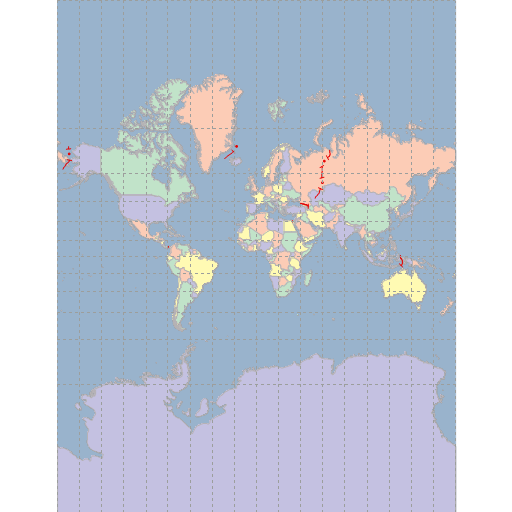
<map_uri>/entireimage[.<format>]
ERROR: Variable (map_link) is undefined.
The entireImage resource, as a child resource of the map resource, is used to get the full extent image of the map (map resource) through implementing the GET request with optional customize parameters in the URI to return the image, such as setting the layers to output, the size of the image, the rotation angle, the target coordinate system of the dynamic projection. The parameters must be included in the URI and must not be put inside the request body.
Supported Methods:
Supported output formats: PNG, BMP, GIF, JPG, RJSON, JSON, HTML, XML.

Implement the HTTP request on the following URI, where supermapiserver is the server name and WorldMap is the map name {mapName}, with PNG being the output format.
http://supermapiserver:8090/iserver/services/map-world/rest/maps/WorldMap/entireimage.png
Gets the full extent image of the map.
Some parameters may be included when performing the GET request on the entireImage resources. If the parameters are included, the server would return the image according to these parameters; if not included, the server would return the image according to the current state of the map. The parameters must be included in the URI and cannot be put inside the request body.
| Name | Type | Description |
| layerName | String | Specifies the layer whose bounding box will be taken as the geographical extent for full extent display. |
| width | int | Specifies the width of the display window/the output image. Must be used together with height. Priority is higher than viewer. |
| height | int | Specifies the height of the display window/the output image. Must be used together with width. Priority is higher than viewer. |
| viewer | The rectangle object | Specifies the size of the display window/the output image. The default size is 256*256 pixels. |
| transparent |
boolean |
Whether the map image is transparent or not. |
| DataImpl | String |
The ID of the layer to output. |
| redirect | boolean | Whether to redirect the request. This is a concept regarding HTTP transport. If the value is true, the request will be redirected to the real address of the image; if the value is false, the response body will then include the byte stream of the image. The default is false. |
| dynamicProjection | boolean | Whether to allow dynamic projection while displaying the map. |
| prjCoordSys | PrjCoordSys | The coordinate system requested. The system will perform dynamic projection if the coordinate system be set is different from the original coordinate system, the map image will be returned at the same time. When using this parameter, it need to be constructed by the fields in PrjCoordSys, input coordinate system by just passing epsgCode is also supported, such as: prjCoordSys={"epsgCode":3857}。 |
| _cache | boolean |
Whether to use cache, the default is True. False means close all the caches. |
| customParams | String |
Custom parameters They can be strings with any combination of characters. This is for users to pass any custom parameters. |
| rectifyType | RectifyType | The rectification method . |
| clipRegion | Geometry | The clipped region on the map for display. This is an areal object, and is supported only when clipRegionEnabled = true, indicating that only the part of the map covered by clipRegion will be displayed. |
| clipRegionEnabled | boolean | Whether clipRegion is enabled. |
| customEntireBounds | Rectangle2D | Custom map boundary. Valid when customEntireBoundsEnabled is true. |
| customEntireBoundsEnabled | boolean | Whether customEntireBounds is enabled. |
| angle | double | The rotation angle of the map. |
| antialias | boolean | Whether the map is anti-alias. |
| backgroundStyle | Style | The background style of the map. |
| colorMode | MapColorMode | The color mode of the map. |
| markerAngleFixed | boolean | Whether the angle of marker symbols is fixed. |
| maxVisibleTextSize | double | The maximum visible size (in pixels) of the text. |
| maxVisibleVertex | int |
The maximum visible vertices of the geometric object. If a geometric feature has more than maxVisibleVertex vertices, the extra vertices will not be displayed. |
| minVisibleTextSize | double | The minimum visible size (in pixels) of the text. |
| overlapDisplayed | boolean | Whether to display the objects when the map object is in the same extent. The default is False. If it is true, the objects in the same extent will be directly overlapped; If it is False, it doesn't display through overlapDisplayedOptions. |
| overlapDisplayedOptions | OverlapDisplayedOptions | Avoid the map object overlapping the filter options. When the overlapDisplayed is false, it is used to enhance the processing when map objects overlap. |
| paintBackground | boolean | Whether to render the background of the map. |
| textAngleFixed | boolean | Whether the angles of the text are fixed. |
| textOrientationFixed | boolean | Whether the orientations of the text are fixed. |
An image will be returned if the output format is specified as PNG, BMP, GIF or JPG if you want to get the map image directly.
If you want to get the image information, you can specify the output format as RJSON, JSON, HTML or XML. The structure of the response will be as follows:
| Field | Type | Description |
| customResponse | String | The custom response. |
| imageData | byte[] | The binary stream of the map image. |
| lastModified | long | The last modified time of the map. |
| imageUrl | String | A URI directed to the map image in PNG format. |
| mapParam | MapParameter | Map parameters. |
Implement GET request on the entireImage resource with http://supermapiserver:8090/iserver/services/map-world/rest/maps/WorldMap/entireimage.png?width=512&height=256 and return the response in PNG, as showed below:

To implement dynamic projection on the current map, and request the output result of the current map dynamically projected to WebMercator projected coordinate system, perform GET request: http://supermapiserver:8090/iserver/services/map-world/rest/maps/WorldMap/entireimage.png?&prjCoordSys={"epsgCode":3857}&width=512&height=512.

Asks for the response identical to the one that would correspond to a GET request, but without the response body. This is useful for retrieving meta-information written in response headers, without having to transport the entire content. The meta-information includes the media-type, content-encoding, transfer-encoding, content-length, etc.
The HEAD request helps check the existence of the entireImage resource and whether it can be accessed by the client. By implementing the HEAD request on the URI, with .<format> appended to the end, we can quickly get to know whether the entireImage resource supports the representation in <format> or not.